|
One of the most active volcanic regions in the world has seen another eruption. The eruption of Puyehue-Cordón Caulle, Chile started on the 4th June and has led to the evacuation of ~3500 from its vicinity. The eruption was preceeded by an increase in fumarolic activity and a swarm of earthquakes on the 27th April which were sourced at ~4-6 km below the surface. Closer to the 4th the earthquakes began to increase in intensity and were also present at shallower levels - indicating the passage of magma up the conduit. A minor eruption occurred in 1990 at Cordón-Caulle however a larger VEI3 eruption occurred in 1960. This has been attributed in various sources to the Valdivia earthquake of 1960 the most powerful earthquake ever recorded on the Earth at magnitude 9.5. The most recent (confirmed) eruption of the Puyehue volcano according to the Global Volcanism Program was in AD 860 (+/-75 years). The Puyehue-Cordón Caulle is a volcanic chain which trends NW to SE (see below) with Puyehue at the most South-Easterly point and the Cordón Caulle fissure system stretching to the NW. The Cordón Caulle fissure system is the most geothermally active area in Chile. The interesting thing about the Puyehue volcano is the diversity of its geochemical characteristics which range from Basaltic to Rhyolitic. There are some more excellent photos of the eruption on the daily mail website and also on the Eruptions blog by Erik Klemmeti and The Volcanism blog.
27/6/2012 09:12:22 am
Pretty nice post. I just stumbled upon your blog and wanted to say that I have truly enjoyed surfing around your blog posts. After all I will be subscribing to your rss feed and I hope you write again soon! Comments are closed.
|
Archives
July 2023
|



 RSS Feed
RSS Feed